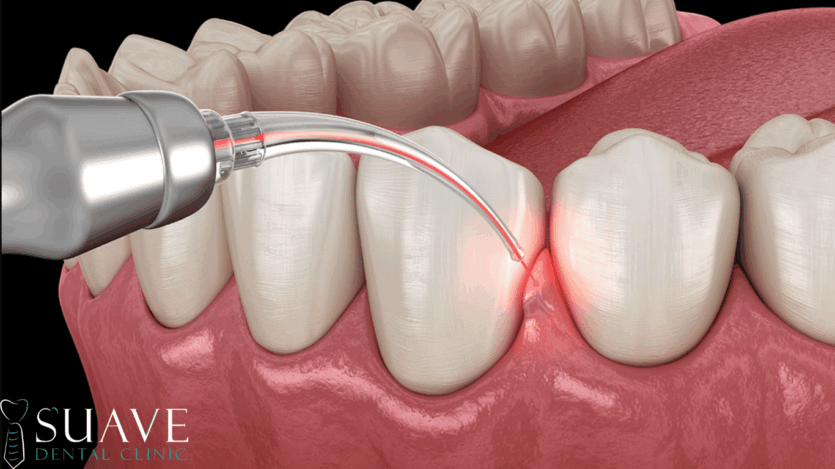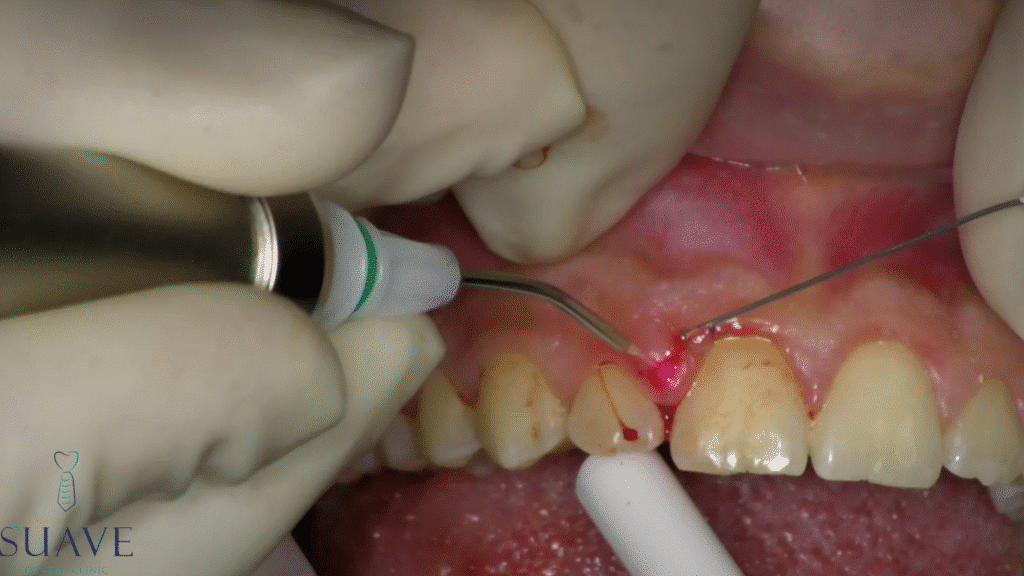
Table of Contents
Pursuing a harmonious, confident smile starts with a healthy, well-shaped gingiva, which boosts self-esteem and plays an important role in a beautiful, appealing smile.
For many individuals, excessive gingiva of a gummy smile that covers parts of their teeth is considered to be less aesthetic and appealing; thus, removal of these excessive gingival tissues is the second most common esthetic procedure done in the dental office after restorative dental fillings.
Gingival hyperplasia, hyperinflamed gums, a gummy smile, and deep pockets can be significant issues and considered obstacles to good isolation during dental filling placement and cosmetic dental treatments, such as dental veneers, crowns, and bridges.
That’s where gingivectomy comes to play an important role in any dental office, and that’s why, at Sauve Clinic, we care to discuss Gingivectomy indications and best practices.
What is Gingivectomy?
Gingivectomy is a surgical cutting off and removal of gum, especially the soft tissue wall of a diseased periodontal pocket. This means that, to scientifically call a surgical gingival excision a “Gingivectomy,” it should include a removal of pathological gingival tissue.
Who needs a Gingivectomy?
Gingivectomy procedures are performed by periodontists and oral surgeons in certain pathological conditions
Patients with pathological periodontal pockets
Patients suffer from deep pockets above the jawbone level, “suprabony pockets” because of periodontal diseases such as chronic inflammation of the gingiva and the adjacent tissues in cases of gingivitis and/or periodontitis.
That’s the most common case where gingivectomy is indicated to be applied, as the excision and removal of the pathological wall of the infected deep pocket allows better cleansing, bacteria and plaque disinfection, curettage, and better healing.
Patients with a gummy smile
Patients suffer from excessive gingival display covering portions of the teeth. Gingivectomy plays an important role in their esthetic enhancement and cutting off the excessive part for gum contouring, gum reshaping, crown lengthening, and better tooth shape and isolation during restorative treatment.
Patients with Gingival Hyperplasia
Gingival hyperplasia refers to the overgrowth of gingival tissue pathologically as a result of certain drug intake, hormonal changes, pregnancy, and so on..
Overgrown gingiva covers portions of the tooth structure or hides teeth completely, creating periodontal pockets and hindering good oral hygiene.
Gingivectomy in this case is mandatory and should be done under certain specifications and instructions, and eliminate the causes of this condition in order to prevent the regrowth of hyperplastic gingiva after gingivectomy procedures.
Patient with Impacted Wisdom
Inflamed, infected gingiva around the impacted wisdom tooth could heal after wisdom tooth extraction. Although the inflamed hyperplastic gingiva “Operculum” around healthy wisdom could be disinfected and healed after removal by gingivectomy.
Patient has chronic deep cavity margins
If the carious tooth cavity is surrounded by localized, inflamed, hyperplastic gingiva overgrowing and protruding into the cavity or the cavity margins are deep and can’t be isolated, gingivectomy is indicated.
Surgical removal of the excessive gum helps in crown lengthening and improves cavity accessibility and good tooth isolation for dental filling placement.
The Benefits of Gingivectomy
- To eliminate periodontal pockets; which is the main objective of Gingivectomy
- To improve accessibility to the teeth to boost oral hygiene.
- Enhanced esthetics by removal of excess gingival display.
- Achieve normal contouring to the gingiva and normal tooth length and shape.
Gingivectomy procedure: step by step
First, a dental consultation is necessary for better diagnosis and treatment plans. At Sauve Clinic, our professional dentists follow diagnosis guidelines like perio-charts to measure and assess the underlying causes of gingival enlargement and the prognosis of gingivectomy.
- Consultation and professional diagnosis
It starts with a thorough evaluation of the patient’s systemic and oral health, followed by X-rays and a profound diagnosis via periodontal probing to determine the depth of the existing pockets, how much of the excessive gingiva should be removed, and the underlying bone health state.
- Determining the type of Gingivectomy procedure
to execute that is suitable for the patient’s condition and the patient’s objectives. - Preparing for the Gingivectomy
Before the procedure, it’s advocated to do professional dental cleaning for teeth and gums to remove dental plaque and tartar (calculus) to reduce the risk of bacterial infection before and after the Procedure.
Then, local dental anesthesia is administered in the area where the procedure will take place to ensure patient comfort and no pain.
Common Methods of Gingivectomy Procedure
Traditional Surgical Gingivectomy
It’s the most common procedure of gingivectomy, as surgical removal of the excessive gingiva is performed using a scalpel and sutures, which help the gums heal in their new position.
The healing period is longer than Laser Gingivectomy procedures.
The main disadvantages are post-surgical bleeding, the risk of infection over the sutures, or gingival tearing around the sutures.
Laser Gingivectomy
That’s the type of Gingivectomy procedure we perform at our dental offices in Sauve Clinic.
Dental lasers are used to remove gum tissue with precision. The laser cauterizes blood vessels as it works, reducing bleeding and boosting healing.
The main pros of Laser Gingivectomy are that they are less complicated, less invasive, and less discomfort to the patient than the traditional Gingivectomy.
Laser Gingivectomy is suitable for cases of Gummy Smile, dental fillings in deep margins, dental veneer placement, and gingival hyperplasia.
ElectroSurgery
This method uses a high-frequency electric current to cut and remove excess gum tissue; it’s more commonly used for small areas where high precision is required.
The main advantage is that it cauterizes blood vessels during the procedure with less bleeding.
The cons are that heat is generated as it works, causing more discomfort to the patient and may cause damage to the surrounding tissue, and requires a longer healing period.
High-Frequency Ultrasonic Surgery
It’s a newer approach that uses ultrasonic vibrations to cut soft tissue. It is highly precise and minimizes damage to surrounding structures and bleeding during and after the procedure, but it hasn’t been tested by many professionals as it’s not widely used yet.
Cryosurgery
It’s a less common technique that uses extreme cold (often liquid nitrogen) to cut and remove excess gum tissue. It’s a bloodless and minimally invasive technique that it’s rarely used.

Gingivectomy aftercare
Post-surgical aftercare is mandatory for a better prognosis of the Gingivectomy procedure.
The patient should follow his dentist’s instructions to boost recovery for faster tissue healing and less infection.
Postoperative gingivectomy care
The post-surgical instructions are similar to post-teeth extraction instructions involving:
- Taking OTC painkillers and anti-inflammatories for 1 week if feeling pain.
- No eating or drinking any hot food or beverages for 2 days.
- No spitting, no mouth rinsing, in order not to remove the blood clot.
- Ice or cold bags over cheeks for the following 30 mins after surgery
- Having a soft diet like yogurt, ice cream, and mashed potatoes for 1 week
- Having only cold to moderately warm beverages for 1 week
- Follow good oral hygiene; soft, gentle brushing and mouthwash
- No smoking or Alcohol for at least 2 weeks.
- Attend the dentist’s follow-up sessions regularly.
Patients may feel discomfort and pain for a few days after the surgery as a wound exists in his /her mouth, which heals faster and cleaner using Laser Gingivectomy than the traditional one.
Risks and Limitations of Gingivectomy
At Sauve Clinic, we guarantee that Gingivectomy is safe and effective. Our professional dentists use advanced laser devices and advanced technology for this procedure, with minimal bleeding, discomfort, and pain sensation according to most of our patients’ reviews after removing the excessive gum tissue.
Receiving treatment from professionals at Sauve Clinic makes you feel more comfortable and confident about the results. It also helps you to take follow-up sessions and aftercare more seriously.
Despite the insignificant risks, there are some limitations of gingivectomy:
- Patients with gum recession
Alternative treatments like soft tissue grafting may be recommended to restore gum health and coverage, which is called a gum grafting surgical procedure. - Gingival attachment is minimal or absent to the underlying bone.
There are also some insignificant cons to the procedure
- Some postoperative pain, sensitivity, and discomfort might be temporary and could be reduced by OTC anti-inflammatories and analgesics.
- Risk of gum infection.
Improper post-surgical care, such as neglecting prescribed oral hygiene practices, can lead to gum infections. - There might be prolonged gum swelling after a gingivectomy, although minor bleeding and swelling are normal immediately after the procedure.
When to choose Gingivectomy or Gingivoplasty?
Gingivoplasty is a cosmetic procedure that reshapes healthy gum tissue to improve its appearance, to achieve the facial symmetry of beauty standards, and to achieve a perfect smile without removing a significant amount of tissue, so many dentists call it gum contouring.
The subtle difference between gingivectomy and gingivoplasty is that gingivectomy is the surgical removal of excess gum tissue to treat periodontal disease or improve aesthetics by removing a significant amount of gingiva.
Choosing Gingivectomy and Gingivoplasty is according to the dentist’s diagnosis of your condition and the causes of gingival enlargement.
Why Turkey is a Popular Choice for Gingivectomy?
Sauve Clinic in Turkey is offering high-quality care at a fraction of the cost compared to countries like the United States or the UK, with more affordable packages on Hollywood Smiles and other cosmetic dentistry restorations.
Patients can receive the same high-quality treatment by our dental expertise with high-standard care for a fraction of these costs, typically ranging between $200 and $700 for the entire procedure.
Most FAQs about Gingivectomy
How painful is a gingivectomy?
The gingivectomy procedure isn’t painful at all under local anesthesia, but there may be some postoperative pain and discomfort that will resolve over a few days.
Do Gums Grow Back After Gingivectomy?
Gums removed during a gingivectomy generally do not grow back to their original state. However, if proper oral hygiene is not maintained, gum tissue may become inflamed or overgrown again due to conditions like gingival hyperplasia or poor oral hygiene.
What foods to avoid after a gingivectomy?
to promote healing and prevent complications, avoid the following:
Spicy Foods: They can irritate the sensitive gum tissue.
Crunchy or Hard Foods: Foods like chips or nuts can damage the surgical site.
Acidic Foods: Citrus fruits and vinegar-based foods may cause discomfort.
Hot Foods and Drinks: High temperatures can worsen swelling or irritation.
Sugary Foods: They encourage bacterial growth, increasing the risk of infection.
Why Gingivectomy May Be Needed During Braces?
Braces can make oral hygiene more challenging, leading to inflammation or gingival hyperplasia (gum overgrowth). This excess tissue and gingival overgrowth may need to be removed according to diagnosis and the dentist’s consultation for better oral hygiene and to prevent complications.
Also, removing excessive gum tissue may improve access for braces adjustments or improve the fit of orthodontic bands.
You should take into consideration that dentists and orthodontists often collaborate to decide the best timing. Gingivectomy is typically done once significant tooth movement has occurred or when gum overgrowth hinders treatment.
At Sauve Clinic, Laser gingivectomy is often preferred because it is minimally invasive, involves less bleeding, and promotes faster healing, making it ideal for patients with braces.
You should pay extra attention to oral hygiene, as there are special tools like interdental brushes or water flossers to clean around the braces and the treated gum area.
There are also some challenges:
Braces can make it harder to keep the surgical site clean, which increases the risk of infection or delayed healing.
If oral hygiene remains inadequate or there is persistent irritation from braces, the overgrowth may return.
Better Diagnosis is the key to determining when and how to perform the Gingivectomy procedure for a better prognosis.
References
Medically Reviewe